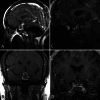Spontaneous regression of Rathke's cleft cysts with conservative management: patient series
- PMID: 39312810
- PMCID: PMC11418645
- DOI: 10.3171/CASE24268
Spontaneous regression of Rathke's cleft cysts with conservative management: patient series
Abstract
Background: Rathke's cleft cysts (RCCs) are benign fluid-filled cysts that develop in the pituitary gland because of the abnormal embryological development of Rathke's pouch. Most RCCs are small and asymptomatic; however, they can present with symptoms or documented growth, sometimes prompting surgical treatment. For smaller asymptomatic lesions, an unknown proportion demonstrates regression over time. This study describes 3 cases of spontaneous RCC regression.
Observations: Three patients with a diagnosis of RCC demonstrated an average decrease of 78% in cyst volume over a mean interval of 3.7 months. One patient experienced the resolution of chronic headaches, whereas the other 2 patients had persistent headaches and endocrinopathies at follow-up. A systematic review included 9 studies that reported results from observational cohorts of patients with RCC, totaling 619 observed patients, with 158 (25.5%) patients demonstrating spontaneous cyst regression. In the patients with cyst regression, the majority had a resolution of symptoms.
Lessons: A substantial proportion of RCC patients managed nonsurgically demonstrated spontaneous regression. There is a role for the conservative management of RCCs in patients without significant symptoms, and surveillance should continue for a minimum of 5 years to confirm cyst stability. For patients undergoing planned surgery, same-day or recent imaging is recommended to prevent operating on involuted RCCs. https://thejns.org/doi/10.3171/CASE24268.
Keywords: Rathke’s cleft cyst; case report; conservative management; pituitary cyst; spontaneous regression.
Figures



Similar articles
-
Rathke's cleft cysts: a 6-year experience of surgery vs. observation with comparative volumetric analysis.Pituitary. 2019 Aug;22(4):362-371. doi: 10.1007/s11102-019-00962-y. Pituitary. 2019. PMID: 31016554
-
Symptomatic Rathke's cleft cyst with a co-existing pituitary tumor; Brief review of the literature.Asian J Neurosurg. 2013 Oct;8(4):183-7. doi: 10.4103/1793-5482.125662. Asian J Neurosurg. 2013. PMID: 24551002 Free PMC article.
-
Characteristics of Rathke's cleft cyst based on cyst location with a primary focus on recurrence after resection.J Neurosurg. 2015 Jun;122(6):1380-9. doi: 10.3171/2014.12.JNS14596. Epub 2015 Feb 13. J Neurosurg. 2015. PMID: 25679272
-
Rathke's cleft cyst marsupialization and repair with a free mucosal graft - Video case report and literature review.Am J Otolaryngol. 2022 Sep-Oct;43(5):103519. doi: 10.1016/j.amjoto.2022.103519. Epub 2022 Jun 4. Am J Otolaryngol. 2022. PMID: 35690516 Review.
-
Rathke's cleft cysts: from pathophysiology to management.Neurosurg Rev. 2024 Sep 3;47(1):522. doi: 10.1007/s10143-024-02742-0. Neurosurg Rev. 2024. PMID: 39223314 Review.
References
-
- Zada G. Rathke cleft cysts: a review of clinical and surgical management. Neurosurg Focus. 2011;31(1):E1. - PubMed
-
- Teramoto A, Hirakawa K, Sanno N, Osamura Y. Incidental pituitary lesions in 1,000 unselected autopsy specimens. Radiology. 1994;193(1):161-164. - PubMed
-
- Barkhoudarian G, Palejwala SK, Ansari S, et al. Rathke’s cleft cysts: a 6-year experience of surgery vs. observation with comparative volumetric analysis. Pituitary. 2019;22(4):362-371. - PubMed
-
- Chong GYC, Tan KCB, Lau EYF, et al. A study on clinical outcomes of Rathke’s cleft cyst in patients managed conservatively. Pituitary. 2022;25(2):258-266. - PubMed
LinkOut - more resources
Full Text Sources

